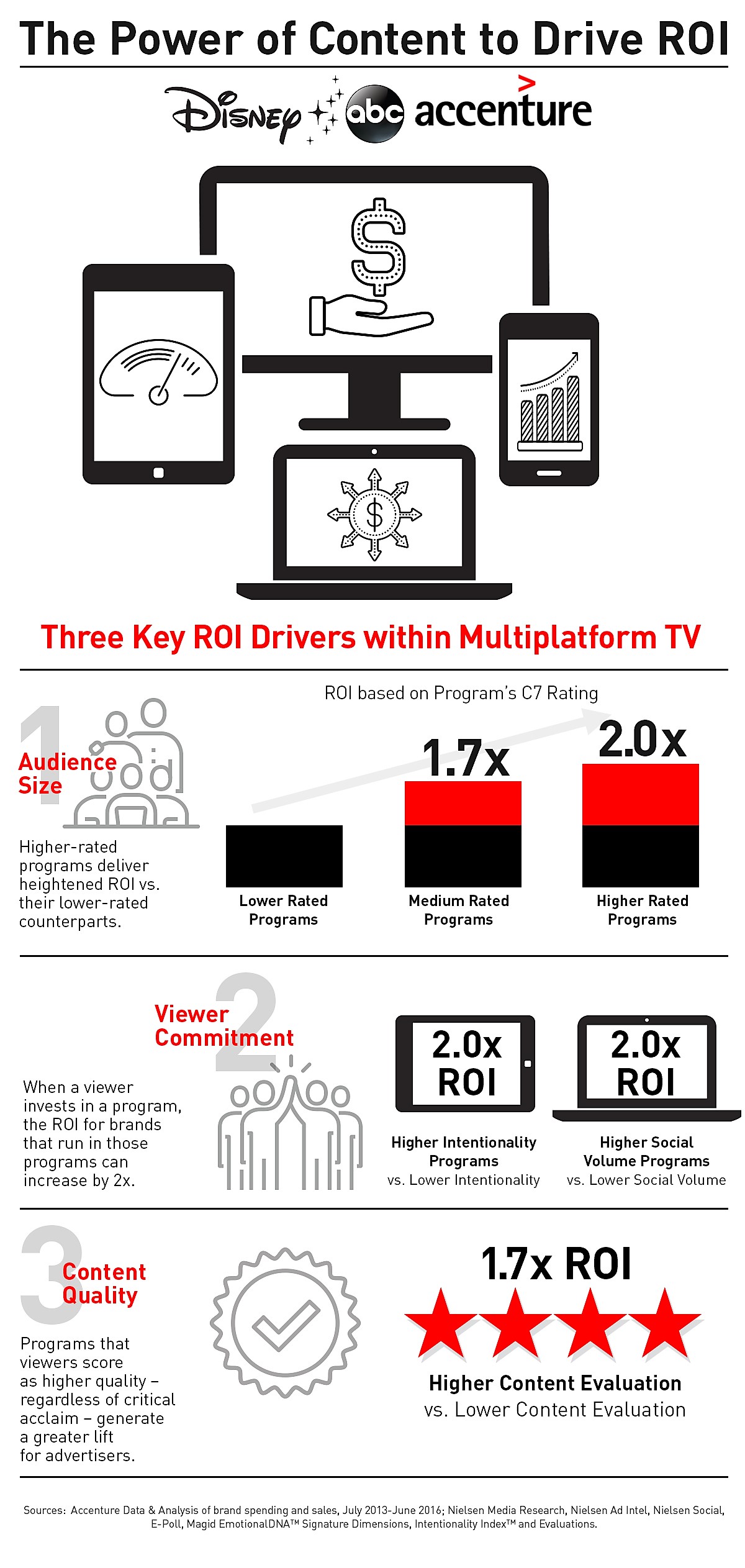ABC and Accenture Strategy Discover the Secret of Sales ROI

One of the more challenging aspects of advertising sales is calculating ROI. This is made even more complex with the proliferation of content platforms and consumer devices. What really contributes to sales uplift? Disney|ABC, in addressing this issue, just released Phase 2 of an attribution analysis conducted by Accenture Strategy. Phase 2 is the follow-up to a custom study completed in 2016 that used four big data sources to prove the role and value of content in context in driving sales ROI.
Cindy Davis, Executive Vice President Consumer Experience, Disney|ABC Television Group, took me through the study and how it contributes to their overall research strategy. “Our objective in this study is to measure what matters and there was industry pressure to measure ROI,” she explained. "In Phase 2 of our study we examined 26 national brands over six industries and their corresponding sales data representing $25 billion in marketing spend, with $11 billion in television spending. We found a very interesting connection between engaged audiences and their content, and the sales and ROI we can drive to clients who participate."
Mike Chapman, Managing Director, Accenture Strategy, Global Lead for Media and Entertainment Strategy Practice, added that his company provided three years of data, which offered a “closed loop view of advertising ROI ... types of impressions delivered, how many, which channels, what prices were paid and the impacts from those impressions, delivered on incremental sales week over week.”
In addition to their marketing data, Davis asked Accenture Strategy to incorporate four other datasets in their recent study: Nielsen ratings, E-Poll, Nielsen Social and Magid’s EmotionalDNA, which Davis described as, “intriguing because we are in the business of connecting with viewers emotionally and Magid’s DNA work speaks to that.”
Phase 1 Takeaways
Focusing on the impact of multi-platform TV (premium long-form video across screens and devices) and how advertisers can leverage that impact, Davis and her team discovered three major takeaways from the Accenture Strategy 2016 study.
- There is a halo effect on sales with multi-platform television. “This doesn’t get talked about a lot,” Davis noted. “You hear about last click attribution in digital advertising. But TV goes a long way to establish and amplify the impacts of all media.”
- Multi-platform is under-valued, under-attributed and under-represented in the industry. Eighteen percent of all of the ROI impact is traditionally attributed to digital, but it should actually be attributed to multi-platform television. “Television has been traditionally undervalued and digital over-valued,” Davis said.
- Multi-platform TV has a long-term amplification impact. The study compared sales lift year-over-year and found that by year two or three, you no longer see a sales lift impact from digital. But the study proved that there is a long-term effect on sales lift with TV.
Phase 2 Takeaways: Drivers of ROI
Davis highlighted three key drivers to ROI that were identified in the Phase 2 study.
- Audience size matters. “Higher-rated programs deliver more ROI than lower rated programs by 2X, so not all programs are created equal, which makes sense,” she said. Notably, these higher-rated programs deliver more ROI than their cost premium, indicating that higher rated and therefore more expensive programming is worth the cost in greater sales lift ROI. This is because these programs have a greater footprint and greater social amplification and therefore have the ability to reach people beyond a narrowly defined target audience.
- Consumers’ commitment to the content matters. “We looked at both the expressed and the observed commitment to the content and found that the greater the effort to watch, the greater the ROI,” Davis said. There is 2X the ROI with Magid’s intentionality measurement.
- Content quality matters. Davis’ group examined perceived quality, as defined by the viewer, and quantified quality indicators using Magid’s emotional dimensions. They found that the higher the perceived quality of the content, the greater the ROI. Using Magid, the three most impactful dimensions for higher ROI were Smarts (programs that are informative, real and inspiring), Edge (unpredictable, outrageous and funny) and Relatability (original, suspenseful and intelligent). “There is a direct connection between the emotions viewers feel about a show and the benefits advertisers get in terms of greater ROI,” Davis noted.
“We are already starting to have good conversations with clients as to what this means for them,” Davis said. “It goes without saying that not all GRPs are created equal and now we can prove that. Yes, higher-rated shows command a premium, but they deliver even greater ROI at that level.” By adding the impact of social connection and emotional dimensions to all of this insight, ABC is poised to help their clients take advantage of the best that multi-platform TV can offer.

Click the social buttons above or below to share this story with your friends and colleagues.
The opinions and points of view expressed in this content are exclusively the views of the author and/or subject(s) and do not necessarily represent the views of MediaVillage.com/MyersBizNet, Inc. management or associated writers.


